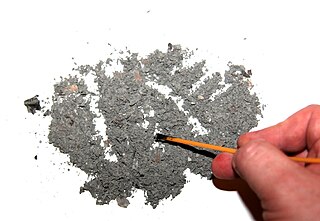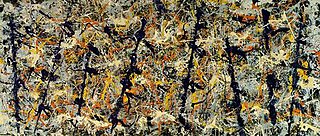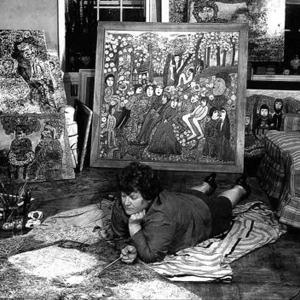
Paul Jackson Pollock was an American painter. A major figure in the abstract expressionist movement, Pollock was widely noticed for his "drip technique" of pouring or splashing liquid household paint onto a horizontal surface, enabling him to view and paint his canvases from all angles. It was called all-over painting and action painting, since he covered the entire canvas and used the force of his whole body to paint, often in a frenetic dancing style. This extreme form of abstraction divided the critics: some praised the immediacy of the creation, while others derided the random effects. In 2016, Pollock's painting titled Number 17A was reported to have fetched US$200 million in a private purchase.
Abstract expressionism is a post–World War II art movement in American painting, developed in New York City in the 1940s. It was the first specifically American movement to achieve international influence and put New York at the center of the Western art world, a role formerly filled by Paris.

Geomancy is a method of divination that interprets markings on the ground or the patterns formed by tossed handfuls of soil, rocks, or sand. The most prevalent form of divinatory geomancy involves interpreting a series of 16 figures formed by a randomized process that involves recursion, followed by analyzing them, often augmented with astrological interpretations. Geomancy was also thought by figures such as Richard II to be a greater discipline that included philosophy, science, and alchemic elements.

Nigromancy, meaning black magic together with six associated practices of black divination, has traditionally referred to the use of supernatural powers or magic for evil and selfish purposes, specifically the seven magical arts prohibited by canon law, as expounded by Johannes Hartlieb in 1456.

Spodomancy is a form of divination by examining cinders, soot, or ashes, particularly although not exclusively from a ritual sacrifice. Spodomancy has been practiced by numerous cultures, ancient and modern, across the globe. While many practitioners have performed the ritual as part of a formal system of paranormal, religious, or ceremonial magic, many have done so as part of mere folkloric practice or superstition.

Lenore "Lee" Krasner was an American abstract expressionist painter, with a strong speciality in collage. She was married to Jackson Pollock. Although there was much cross-pollination between their two styles, the relationship somewhat overshadowed her contribution for some time. Krasner's training, influenced by George Bridgman and Hans Hofmann, was the more formalized, especially in the depiction of human anatomy, and this enriched Pollock's more intuitive and unstructured output.

Sandpainting is the art of pouring coloured sands, and powdered pigments from minerals or crystals, or pigments from other natural or synthetic sources onto a surface to make a fixed or unfixed sand painting. Unfixed sand paintings have a long established cultural history in numerous social groupings around the globe, and are often temporary, ritual paintings prepared for religious or healing ceremonies. This form of art is also referred to as drypainting.

Color field painting is a style of abstract painting that emerged in New York City during the 1940s and 1950s. It was inspired by European modernism and closely related to abstract expressionism, while many of its notable early proponents were among the pioneering abstract expressionists. Color field is characterized primarily by large fields of flat, solid color spread across or stained into the canvas creating areas of unbroken surface and a flat picture plane. The movement places less emphasis on gesture, brushstrokes and action in favor of an overall consistency of form and process. In color field painting "color is freed from objective context and becomes the subject in itself."

Tasseography is a divination or fortune-telling method that interprets patterns in tea leaves, coffee grounds, or wine sediments.

Blue Poles, also known as Number 11, 1952 is an abstract expressionist painting by American artist Jackson Pollock. It was purchased amid controversy by the National Gallery of Australia in 1973 and today remains one of the gallery's major paintings.
Methods of divination can be found around the world, and many cultures practice the same methods under different names. During the Middle Ages, scholars coined terms for many of these methods—some of which had hitherto been unnamed—in Medieval Latin, very often utilizing the suffix -mantia when the art seemed more mystical and the suffix -scopia when the art seemed more scientific. Names like drimimantia, nigromantia, and horoscopia arose, along with other pseudosciences such as phrenology and physiognomy.

No. 5, 1948 is a 1948 painting by Jackson Pollock, an American painter known for his contributions to the abstract expressionist movement. It was sold on 22 May 2006 for $140 million, a new mark for highest ever price for a painting, not surpassed until April 2011.
Drip painting is a form of abstract art in which paint is dripped or poured on to the canvas. This style of action painting was experimented with in the first half of the twentieth century by such artists as Francis Picabia, André Masson and Max Ernst, who employed drip painting in his works The Bewildered Planet, and Young Man Intrigued by the Flight of a Non-Euclidean Fly (1942). Ernst used the novel means of painting Lissajous figures by swinging a punctured bucket of paint over a horizontal canvas.

Janet Sobel, born Jennie Olechovsky, was a Ukrainian-born American Abstract Expressionist painter whose career started mid-life, at age forty-five in 1938. Sobel pioneered the drip painting technique that directly influenced Jackson Pollock. She was credited as exhibiting the first instance of all-over painting seen by Clement Greenberg, a notable art critic.

Autumn Rhythm is a 1950 abstract expressionist painting by American artist Jackson Pollock in the collection of the Metropolitan Museum of Art in New York City. The work is a distinguished example of Pollock's 1947-52 poured-painting style, and is often considered one of his most notable works.

The conservation and restoration of paintings is carried out by professional painting conservators. Paintings cover a wide range of various mediums, materials, and their supports. Painting types include fine art to decorative and functional objects spanning from acrylics, frescoes, and oil paint on various surfaces, egg tempera on panels and canvas, lacquer painting, water color and more. Knowing the materials of any given painting and its support allows for the proper restoration and conservation practices. All components of a painting will react to its environment differently, and impact the artwork as a whole. These material components along with collections care will determine the longevity of a painting. The first steps to conservation and restoration is preventive conservation followed by active restoration with the artist's intent in mind.
Fractal expressionism is used to distinguish fractal art generated directly by artists from fractal art generated using mathematics and/or computers. Fractals are patterns that repeat at increasingly fine scales and are prevalent in natural scenery. Fractal expressionism implies a direct expression of nature's patterns in an art work.

Mural is a 1943 large painting by American artist Jackson Pollock. Although signed and dated 1943, the signature and date were not added until 1947, and the work was probably completed around the fall of 1943. It was made with oil paint on linen, and is Pollock's largest canvas, measuring 2.43 by 6.04 metres. The work was commissioned by Peggy Guggenheim for the long entrance hall of her townhouse at 155 East 61st Street in New York City.
Aspidomancy is a form of divination based on the interpretation of patterns on a shield. Reading the patterns is believed to give some insight into the future. Readers study the shield, looking for a pattern that may represent symbols or pictures. They interpret these symbols and pictures as clues as to what is going to happen in the future.
One: Number 31, 1950 is one of the largest and most prominent examples of a Jackson Pollock Abstract Expressionist drip-style painting. The work of art was owned by a private collector until 1968 when it was purchased by Museum of Modern Art (MoMA) in New York City and has been displayed there ever since.













